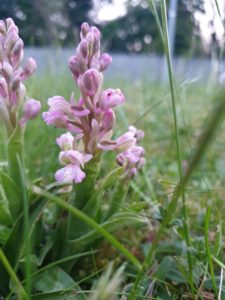2020 County Report for Co. Laois
Dr Fiona Mac Gowan and Dr Mark Mc Corry
- Fiona gave a zoom lecture to representatives of all the TidyTowns groups in Co. Laois organised by Suzanne Dempsey, Environmental Awareness Officer of Laois Co. Co.
During the Pandemic year of 2020 with normal recording travels impeded here’s a list of sites we did manage to visit:
- Killermogh Church of Ireland graveyard, Ballacolla, Co. Laois – lots of Cowslips
- Timahoe Esker woodlands – profuse Bluebells & Early purple Orchids
- Boston Bridge fen – Fly orchids & Marsh fritillary butterflies
- Lisbigney fen – Mark’s first sighting of Adder’s tongue fern in Co. Laois
- The Mash, Shanahoe Marsh, a large area of flood meadows along the river Nore which is significant for its extensive semi-natural grassland communities, still managed as traditional hay meadows. Profuse Green-winged Orchids & Cowslips noted here growing on a dry ridge above the wet grasslands
- The Ridge of Maryborough esker – area featuring hundreds of Bee Orchids and Pyramidal Orchids on the rough edges of an industrial estate in Portlaoise town
- Fen near Ballybrittas featuring three different varieties of Marsh Orchid: the purple form; the fleshy-light pink form and a completely white form
